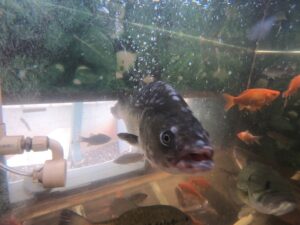Phosphorus deficiency is not common in aquaponics systems. However, phosphorus is important for the growth of new tissues and the division of plant cells. Plants require phosphorus for the energy to grow and bear fruits. Low amounts will stunt plant growth, and plants will fail to bear fruit. Here are some functions of
phosphorus:
- Allows fruit and flower growth – Phosphorus triggers fruit and flower growth.
- Helps plant development – Plants need phosphorus to fully develop. It is one of the main components needed for fruits to reach normal size.
- Stimulates root development – Phosphorus enables the plant to absorb the nutrients from the water.
- Resists diseases – Plants with enough amounts of phosphorus have a higher resistant to diseases.
- Distributes nutrients to the plants – Phosphorus transports nutrients
throughout the plant.
How to Identify Phosphorus Deficiency
Phosphorus deficiency is not as obvious to recognize. Here are some symptoms of phosphorus deficiency:
- Darkening of the base of the plant – Plants will show a purple or reddish color at the base.
- Reddish-purple on the edges of the plant – Purple will start in the leaf veins and spread to color the entire underside of the leaf, this usually starts on older growth first.
- Brown spots on leaf – Dead, brown spots appear on leaves.
- Shiny leaves with yellow areas
- Small leaf size – Phosphorus starved plants will not produce as much vegetation giving them a spindly appearance.
- Small fruit size – Plants with a phosphorus dificiency will have smaller fruit sizes and lower yield.
- Thickening of leaves – Leaves become dry and stiff.
How to Treat Phosphorus Deficiency
Treating phosphorus deficiency in your aquaponics system requires adding phosphorus to the grow-bed and it is important to avoid putting it directly into fish tank. This is because algae thrives on phosphorus, which will develop algae bloom, which is bad for the system. Here is the recommended method:
Rock phosphate is the most common method used in adding phosphorus to the system. Use phosphorus or phosphate that comes as powder or granules. It is recommended to aim around 20 to 40 ppm of phosphorus for your fruiting plants. Avoid putting it on plants that don’t bear fruit. Don’t add it directly to the fish tank, instead, put it directly in the grow-bed. Make sure to provide shade for the plant to shield it from direct sunlight to ensure it doesn’t dissolve before the plant can absorb it.
How to Prevent Phosphorus Deficiency
Maintaining a 6-7 pH water level and feed the fish with a balanced and complete diet is the best way to prevent a phosphorus deficiency. Providing all the nutrients plants require to grow, is also good way to prevent phosphorus deficiency. Add worms to the grow-bed to help break down all the solids which will provide your grow-beds with all the needed nutrients to flourish. Phosphorus usually only needs to supplement one time each growth cycle. Too much phosphorus can prevent other plants from intake of nutrients such as calcium, iron, and magnesium




